Posts Tagged ‘dogs’
What Pets Do To Make Our Lives Better
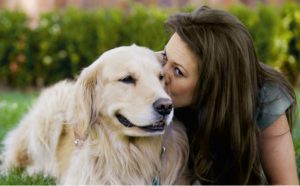 As many of you know, I usually write monthly blogs informing the readers about what we can do to make your pets’ lives better and happier. However this month, I am reversing the trend and writing about what pets do to make our lives better.
As many of you know, I usually write monthly blogs informing the readers about what we can do to make your pets’ lives better and happier. However this month, I am reversing the trend and writing about what pets do to make our lives better.
It is a proven fact that pets can reduce anxieties that we have. To people with anxieties, pets can be like a superhero. Everyone has their own coping mechanisms that work for them, but sometimes having a pet can curb anxiety. By just having a pet present, even though it can’t talk, a person’s phobic and anxiety disorders are often reduced by the pets companionship. This relationship builds self confidence for people that are anxious when they go out in the world.
With depression, people tend to self isolate. So with having a pet, people are forced to go out and walk.
Pets are always down to cuddle. That contact can do wonders to curb anxiety. Maybe it makes you feel less alone or less like you have to handle everything by yourself. With this bonding, one gets a mutual relationship in which the pet and owner give warmth, love and nurturing. Research has also shown that tactile sensations can even lower blood pressure.
Pets are always the ones that listen and don’t ever offer advice. As humans, sometimes we don’t want advice—we just want to vent. A pet will never try to fix you. You can sit for hours on end ranting and they will never try to solve you or your problems. A pet sitting there listening loves you and sometimes that is all you need.
Pet ownership is good not only for people living alone, but for whole family systems. Pets become full members of the family in which lots of interaction swirls around children, parents and siblings as they compete to feed, love and care for the pet. So with a pet at home, this offers a distraction so that a tiny bit of anxiety doesn’t amplify to a big deal. Pet ownership can teach children the value of life in addition to providing them with some sort of responsibility of care and feeding.
Having a pet at home means that there is someone waiting for you to come home and be with you when you are there. Having a pet can give one a sense of security and help with dealing with aloneness better. A pet can provide someone to talk to in order to ease your nerves. A pet there will mean that you are never alone.
Having a pet can help us meet new people. With pet ownership, it requires responsibility and part of that is exercising your dog. While on walks you can make friends and hold conversations with other people. Pets are a great conversation starter, so with them, we can socialize.
No matter what, pets offer unconditional love. Sometimes it feels like no one really likes you. But your pet will always be that person that is on your side.
The benefits of pet ownership are many and they are very much an integral part of our lives. Because of this, we want them to live as long as possible. So it is important to take care of them. If you have any questions, please don’t hesitate to call us at 656-5868.
How To Get The Skunk Smell Out of Your Pet’s Fur
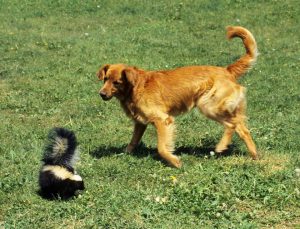 Ooh, that skunk smell. We all know that odor when our beloved dog comes back in and has had the unfortunate pleasure of meeting the neighborhood “Pepe Le Pew.” No matter what, the odor is very unpleasant and tends to linger wherever your pet lies. The skunk oil from the spraying can linger for up to a year if it is not removed from your dogs’ skin and coat. So it is essential that you effectively clean and bathe your pet.
Ooh, that skunk smell. We all know that odor when our beloved dog comes back in and has had the unfortunate pleasure of meeting the neighborhood “Pepe Le Pew.” No matter what, the odor is very unpleasant and tends to linger wherever your pet lies. The skunk oil from the spraying can linger for up to a year if it is not removed from your dogs’ skin and coat. So it is essential that you effectively clean and bathe your pet.
I have found that the first thing you do not want to do is to bring you pet inside. As stated before, the scent can linger for up to a year and anything that your pet has touched can harbor the odor. So leave it outside. Skunk spray is very irritating to your dogs eyes. So if you notice their eyes watering or red, then rinse them with water or gentle eyewash solutions. Any solution but Visine is fine. Once you have addressed the face, it now time to tackle the smell on his body.
There are several methods that can be used for de-skunking a dog, however most methods will need to be repeated more than once. The best formula that I have found is as follows:
- ¼ cup of baking soda
- 1-2 teaspoons of mild dishwashing detergent such as Ivory Snow
- 1 quart of 3% Hydrogen Peroxide solution
- Mix in bucket and use immediately
- Work the foaming mixture well into the coat
- Leave on for five minutes
- Rinse with warm water
- Follow with dog shampoo if desired
The quicker you can get to it, the better the results since the oil hasn’t saturated into the hair yet. It may be necessary to repeat the procedure several times.
It is important to be careful around the eyes as hydrogen peroxide can burn and irritate the eyes. The hydrogen peroxide may also bleach your pets’ coat blond so be careful with black coated dogs. Also discard the solution after use and never store it in a closed container as it will explode.
While no method is foolproof, there are many ways to help your dog avoid getting sprayed by a skunk again. Since skunks are nocturnal animals, consider leaving a light on in the yard or accompany your dog outside when you take it out in the evening. You may also set up some solar lights so that your yard is well lit throughout the night. Automated sprinklers set to turn on throughout the night may also be a good way to deter skunks from roaming in your yard. Always remember to cover your trash cans and take your dogs indoors for treats at night so that skunks aren’t lured in by a possible free meal. If you believe that you have a serious skunk problem you may want to call a critter control specialist to assist in removing the unwanted pest.
If you have any questions or other solutions about pests like skunks, we would like to hear from you. Please call us at (618)-656-5868 or contact us here.
Dr. Olsen’s Breed Spotlight: Barbet Dogs
 There are over 340 dog breeds in the world, but only 167 breeds are recognized by the AKC here in the United States. This month for our breed spotlight, I am highlighting a breed that has a storied history. Surprisingly, it has only been recently recognized as a distinct breed by the AKC organization. Let me introduce you to — the Barbet. At one time there used to be around 25 in the whole United States, now there are an estimated 300 Barbets in the country.
There are over 340 dog breeds in the world, but only 167 breeds are recognized by the AKC here in the United States. This month for our breed spotlight, I am highlighting a breed that has a storied history. Surprisingly, it has only been recently recognized as a distinct breed by the AKC organization. Let me introduce you to — the Barbet. At one time there used to be around 25 in the whole United States, now there are an estimated 300 Barbets in the country.
Barbet’s (pronounced bar-bay) are a breed that has been traced possibly back to the 14th century for hunting waterfowl in France. One person of royalty who was noted to be fond of them was Henry IV. There is a story in history that one of the king’s mistresses was told off for trying to bring one into a church. It is thought to be related to such breeds as the Poodle, American Water Spaniel, the Otterhound and the Portuguese Water Dog. In fact for many years, the Barbet and the Poodle were referred to as the same dog. It’s main usage was for hunting game and retrieving waterfowl. The breed survived for many years, however it was nearly extinct due to loss of huge numbers during World Wars I and II. Through the efforts of a very devoted few, the old breed is being reborn as a dog of the future.
Barbets have a wooly coat that gives them excellent protection when working. They also have a distinct beard, hence where their name came from, ( “barbe” is french for beard.) They have webbed paws to make them fantastic swimmers and are sometimes referred to as the “mud dog” because it would often get pretty dirty in pursuit of waterfowl.
This medium-sized dog averages between 35 and 60 pounds with heights of 19 to 24 inches at the withers. They have a life span of 12 to 15 years. The Barbets are very intelligent and perform well in confirmation, agility, obedience, rally and retrieval trials. Barbets are calm, friendly and affectionate, so they can be good pets for families as long as their exercise needs are met. They enjoy outdoor activities and are gentle with children, which can make them attached to their families. Sometimes they may suffer from separation anxiety. They are also good with other pets including cats if they are socialized at an early age.
Barbet’s are all shades of black, gray, brown, and fawn with or without white markings. They have long ears that extend past their jaws. Because they have hair and not fur, they can be considered hypoallergenic making them a good option for people who want a dog but suffer from allergies. Because the hair is so long, they will require some commitment to brushing and combing the long coat daily so that it doesn’t matte, especially if they swim a lot. It is also a breed that will need to be taken to a professional groomer regularly so that the hair can be trimmed from its feet and ears.
Surprisingly, Barbets are a relatively healthy breed, with just a few health issues noted as common in the breed. These include elbow dysplasia, hip dysplasia, eye problems, such as entropion and cataracts, and epilepsy.
In general, the Barbet is a great dog for hunting if you need a soft-mouthed retriever, or as a family companion. It can live in homes for most type of people including young and old. It does need exercise so it will need room to explore. Barbets are friendly, loving and devoted and will want to hang out with you and it prefers that you not be out all the time. It is a brave dog that is quite happy to play around in the mud, so get ready for some fun bath times if this breed for you.
Can You Spay Or Neuter an Older Pet?
 With the new year, it is always time to make resolutions. One of these may be to help control the pet overpopulation by having your pet spayed or neutered to prevent any unwanted pregnancies. If a client asks me what my opinion is, I would definitely recommend to spay or neuter your pet – even if the pet is older and reaching geriatric years in age.
With the new year, it is always time to make resolutions. One of these may be to help control the pet overpopulation by having your pet spayed or neutered to prevent any unwanted pregnancies. If a client asks me what my opinion is, I would definitely recommend to spay or neuter your pet – even if the pet is older and reaching geriatric years in age.
By neutering your male pet, you will be able to curb its behavior that has been influenced by the male hormones such as testosterone. Neutering may help lessen aggressiveness that is stimulated by the presence of female hormones. It will also help reduce and prevent prostate and testicular cancer that can be seen in older male pets that have not been neutered. Neutering may also help prevent spraying in male tomcats. I want to dispel any myth that neutering will make your pet lazy or cause obesity.
When we spay female pets, we are performing what we call an ovariohysterectomy. This is the removal of the uterus and the ovaries. Females can carry even more serious risks if they are un-spayed, which is why you would want to spay even if they are older. Un-spayed females can develop a condition called a pyometra tha is essentially an infection of the uterus that continues to manifest itself. If left untreated, your pet will probably die as a result of the uterus rupturing and causing an abdominal infection, so these are treated as an emergency. Spaying is indicated at this time, however the surgery is a lot more complicated and complications can arise due to the toxicity that the infection is causing. Spaying will also help reduce the risk and incidence of mammary cancer in pets. This is based on the lack of female hormones that were produced from the ovaries that were removed during the surgery.
Because of the hormones, female dogs and cats have their estrus cycles about every 6 to 8 months. During that time, their female organs can swell and create a discharge. These scents that are given off can attract males. So not only are you risking pregnancies but also complications that can follow.
Pet owners tend to worry that their older pet may not handle the anesthesia or surgery well, but pre-surgical bloodwork can help reduce or alleviate the issue with the anesthesia and make it as safe as possible.
Any time a patient undergoes a surgery, there is a risk, albeit a slight risk. The benefits from spaying or neutering clearly outweigh not doing so. If you have any questions, please feel free to contact us here at the Olsen Veterinary Clinic and we would be happy to answer any questions or dispel any myths that you may have heard.
Holiday Pet Toys For 2017
 With the holidays rapidly approaching, pet owners usually ask for gift ideas for their four-legged companions. As with every other Santa’s list from our children, electronics and technology play an important part in holiday pet toys. So without further adieu, I will introduce some ideas that might be appealing to the pet owner with the pet in mind.
With the holidays rapidly approaching, pet owners usually ask for gift ideas for their four-legged companions. As with every other Santa’s list from our children, electronics and technology play an important part in holiday pet toys. So without further adieu, I will introduce some ideas that might be appealing to the pet owner with the pet in mind.
- Bascolor Electric Rotating Butterfly– This gift from Amazon is for the cat owners who want to keep their kitten active. It is described as a butterfly that flashes in the dark that will fulfill your kitty’s hunting urges.
- Cat Scratcher Lounge– This cardboard lounge is infused with catnip that your cat is going to be addicted to in record time. It also can be used as a scratch board. Available from Amazon for about $20.
- K&H Crinkle Sack Cat Bed– This cat bed makes the noise of a paper bag that your cat will love. Inside, it is covered with a plush lamb wool that is easy to wash and take care of. The overstuffed bolster keeps the sack open for easy access for your kitten. It is also available on Amazon.
- Nerf Tennis Ball Blaster– This toy will launch tennis balls 50 feet in the air and is easy to operate. It works with standard tennis balls but if you get the lighter replacement balls they will go farther. No need to touch the slimy ball because it is easy to reload.
- Pet Acoustics Pet Tunes Calming Music Dog Speaker– A bluetooth speaker that is preloaded with 90 minutes of music developed by a sound animal behaviorist to reduce stress and calm nervous canines. It alleviates stress and related behaviors such as excessive barking and pacing which can happen when your pet is home alone during thunderstorms, traveling or when it is adapting to new environments. It comes complete with a rechargeable battery.
- GPS tracking systems– There are many available for the high tech owner that can have a GPS and activity monitor which set up virtual fences to indicate safe zones and give notifications where your pet has traveled too far. They range in price starting at $39.
- Furbo Dog Camera– For the really techie person that wants to see, talk and toss treats to your dog even when you are not at home. It gives smart dog alerts and the camera gives peace-of-mind to the dog’s parents. The camera lets you see, talk and toss treats from anywhere and sends alerts when your dog barks. The two-way camera allows you to hear and speak to your dog and works with Amazon Alexa.
- Pet DNA testing– By discovering your pet’s ancestry, pet owners and veterinarians can work together to tailor wellness plans that fit the unique one-of -a-kind needs of the dog. It helps owners discover typical ailments that certain dogs can have over one another and provide insight to personality traits of the breeds in your dog’s genetic make up. It is also available for cats. Price ranges from $70 to $180.
This is not an all-inclusive list, but it may give pet owners ideas when shopping for our four-legged friends. At this time, I would like to thank each and all of my clients for their loyalty and business that have come my way. May each and everyone have a happy and safe holiday season and a prosperous 2018. Don’t forget to contact us at any time, even during holiday emergencies, if you have any questions.
The Trouble With Table Scraps
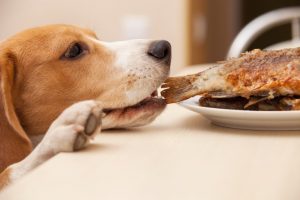 If the holidays are at your place like it is at our place, it is family, food and football—not necessarily in any order. Unfortunately many pet owners think that holiday time means giving their pets a taste of the tender morsels that they partake in. Before you give table scraps – STOP and think a minute. These high-fat type of foods or foods that your pet is not accustom to can lead to disaster if given to our pets. Just a small amount can lead to pancreatitis in our pets, which can lead to terrible consequences.
If the holidays are at your place like it is at our place, it is family, food and football—not necessarily in any order. Unfortunately many pet owners think that holiday time means giving their pets a taste of the tender morsels that they partake in. Before you give table scraps – STOP and think a minute. These high-fat type of foods or foods that your pet is not accustom to can lead to disaster if given to our pets. Just a small amount can lead to pancreatitis in our pets, which can lead to terrible consequences.
If your pet develops pancreatitis, the treatment focuses on supportive care, such as controlling nausea and vomiting, preventing further dehydration or imbalances in the blood and feeding a low-fat nutritious diet. Serious cases may mean hospitalizing your pet for a few days or longer. Unfortunately, many other diseases have these clinical signs and it makes it a challenge determining if your pet has pancreatitis.
Early diagnosis and treatment is the key to preventing other complications such as dehydration and other systemic diseases.
As your pet ages, he can develop intolerances to certain foods so it may be best to just feed high quality pet foods with little variance and only allow healthy pet treats in moderation.
Most owners know that a only a good quality diet is necessary for their pet, however sometimes good intention visiting guests can complicate things by letting them finish their plate or giving them all of the trimmings off the turkey because they couldn’t resist.
This kind gesture could lead to the previous mentioned consequences.
To avoid pancreatitis a pet owner may take precautions to prevent it. This may include:
- Ask guests to not feed your pet table scraps
- Have healthy treats present if your guests can’t resist
- Keep pets out of the garbage
- Place your pet in a quiet room during mealtime or feed it prior to you and your guests eating
Holidays are all about celebrating and pets are a big part of our family. Kind gestures like feeding table scraps can put a damper on the celebrating if it involves an emergency trip to your veterinarian. So if you set ground rules and make your guests aware of the restrictions for your pets, we can have a safe and happy holiday season.
Olsen Veterinary Clinic is committed to the health and happiness of your pet. For questions, or to schedule an appointment, contact us here.
Everything You Ever Wanted To Know About Pet Vaccines
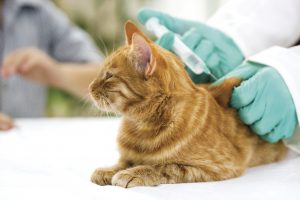 Pet vaccines are important, and they have a long history. Probably the most important technological gains were discovered in the 1790’s by Dr. Edward Jenner. He discovered the first vaccination by giving people a preparation of material from cowpox, which was a common animal disease in cattle. The people that were injected with or “vaccinated” with the material did not get sick and remained healthy when they were exposed to the deadly smallpox virus. Over 100 years later, a French scientist by the name of Louis Pastuer, found that they could protect people and animals from disease by injecting altered forms of microorganisms.
Pet vaccines are important, and they have a long history. Probably the most important technological gains were discovered in the 1790’s by Dr. Edward Jenner. He discovered the first vaccination by giving people a preparation of material from cowpox, which was a common animal disease in cattle. The people that were injected with or “vaccinated” with the material did not get sick and remained healthy when they were exposed to the deadly smallpox virus. Over 100 years later, a French scientist by the name of Louis Pastuer, found that they could protect people and animals from disease by injecting altered forms of microorganisms.
The process of how a vaccine works is a complex reaction that involves many chemical and cellular reactions within and between the immune system cells of the body. Basically the role of the vaccine is to expose the immune system of the pet to viral and bacterial antigens that are contained in the vaccine. In the future, when the pet is exposed to that related organism, the body will recognize it and then activate the immune system to prevent the disease from producing or reducing the signs of clinical disease.
Vaccines can be administered by subcutaneous or intramuscular injections, intranasal or orally. The vaccines that are injected or given orally tend to produce a more systemic or whole body response, whereas the intranasal provides a more local response. Intranasal vaccines can be advantageous to provide a quicker response and prevent or kill the new virus before it can get any further in the body. Local nasal vaccines would not be helpful for a virus that has been ingested and causes intestinal disease such as parvovirus in dogs. For that we would want a vaccine that would produce a more systemic response.
The vaccines that we use in veterinary medicine are most generally either a killed or a modified live (attenuated) vaccine. There are multiple indications for both, but generally speaking the killed vaccines are safer and unlikely to cause disease in the immunocompromised pet. Whereas, the live vaccines provide a more amplified response that leads to a better, longer lasting immune protection. Several of the vaccines that we use have many different viruses in one injection. This allows to vaccinate for several of the organisms in one injection.
To confuse you even more, pets get some protection through the placenta when the puppies and kittens are in the mother’s uterus and when they get colostrum which is the first milk that they drink. This protection will decrease over time and usually will be low enough by 12 weeks of age where vaccinations will start reacting. There is no way to measure quick, easy and inexpensive way to measure the immunity gained here, so we generally recommend starting vaccines at 6 to 8 weeks of age and then booster them every 2 to 4 weeks until they are 16 weeks of age. Generally, it is not the number of vaccinations that they get, but when they get them at their chronological age.
A vaccine helps prime an animal against a specific disease. It does this by stimulating the immune system with a nonpathogenic virus or bacteria. If the animal responds adequately, it will develop cells that will help it to quickly and efficiently fight off the pathogenic form of the agent if it is encountered later. Here at Olsen Veterinary Clinic, we have tailored our vaccination programs to meet the needs of your pet. If you have any questions please feel free to contact us here, or call our office at 618-656-5868.
Human Medications and Pet Medications Are NOT Created Equal
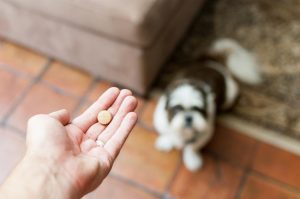 In today’s society, almost everyone has some medications – whether over-the-counter or prescription sitting around at home. The important thing to remember, however, is that human medications and pet medications are NOT created equal. While some human medications are safe, some can be very toxic to pets if they happen to ingest them. As a matter of fact, the Pet Poison Hotline reports that nearly 50% of the calls involve human medications. These issues can arise if your pet accidentally chewed into the pill bottle or a well-intentioned pet owner gave their pet a human medication. Pet poisonings are common, can be very serious, and spell disaster for a beloved pet.
In today’s society, almost everyone has some medications – whether over-the-counter or prescription sitting around at home. The important thing to remember, however, is that human medications and pet medications are NOT created equal. While some human medications are safe, some can be very toxic to pets if they happen to ingest them. As a matter of fact, the Pet Poison Hotline reports that nearly 50% of the calls involve human medications. These issues can arise if your pet accidentally chewed into the pill bottle or a well-intentioned pet owner gave their pet a human medication. Pet poisonings are common, can be very serious, and spell disaster for a beloved pet.
With that in mind, listed below are 10 medications that can cause toxicity to your pet and therefore should be kept away from them.
NSAIDS – Non-Steroidal Anti-Inflammatory Drugs are common, everyday drugs that are found in most households. This classification includes popular drugs like Aleve, Advil and Motrin. The side effects can be some of the most dangerous drugs for pets to ingest. In fact just 1 or 2 pills can cause pets to suffer serious stomach and intestinal ulcers and in some cases cause kidney failure.
Acetaminophin – For that occasional headache or fever, almost everyone has some Tylenol sitting around their home. As safe as it is for children the opposite is true for pets. Just a small dose of acetaminophin can cause damage to your pet’s red blood cells, reducing its ability to carry oxygen through the body. The drug can also cause liver damage in your pet.
Birth Control Pills – Dogs usually mistaken the birth control containers for toys, but if they swallow a large number, they can get ill. Estrogen and Estradiol have shown to cause bone marrow suppression in pets. Surprisingly, female pets have an increased risk of suffering from the most serious side effects.
Antidepressants – Veterinarians have at times prescribed medications meant for humans to pets like Prozac. When used as your veterinarian has prescribed, they are safe. But accidental or overdose can be toxic to your pet. These clinical signs can include serious neurological problems that include sedation, loss of coordination, tremors and even seizures.
ADHD/ADD Medications – Prescription medications for this human condition are very strong stimulants like amphetamines and are very dangerous for pets. Ingestion of small amounts can cause life-threatening tremors, seizures, elevated body temperature and heart problems. Drugs in this category include Adderall, Ritalin and Concerta.
Benzodiazepines and Sleep Aids – Drugs like Xanax and Ambien are given to humans to reduce anxiety and help sleep better. However in pets, it can cause the opposite. It has been shown that small doses can cause pets to be agitated, along with severe lethargy, incoordination, and a slowed breathing rate. In cats, it has been known to cause liver failure.
Beta-blockers – Beta-blockers are commonly prescribed drugs for humans suffering from blood pressure problems. But all it takes is a small amount for pets to ingest to make it life-threatening to them. These drugs can cause severe drops in blood pressure and a very slow heart rate.
Ace-Inhibitors – Like in humans, these drugs are often used in veterinary medicine to treat pets suffering from high blood pressure. Though typically safe, overdoses can cause low blood pressure, dizziness, and weakness. If pets have ingested just a small amount of this medication, they can be monitored at home unless they have kidney failure or heart disease.
Cholesterol-Lowering Drugs – Drugs like Lipitor are advertised on the TV and are now found in many households in America. While these drugs are considered statins, long term use can potentially leads to problems. In most cases, one may see some mild form of intestinal upset which would include vomiting or diarrhea.
Thyroid Hormones – These medications are routinely prescribed for pets that have underactive thyroids. Surprisingly the thyroid hormone needed to treat dogs is much higher than a persons dose. So, if dogs accidentally get into thyroid hormones, it rarely results in problems. In cats it can be a different story. Large overdoses in cats can cause muscle tremors, nervousness, panting, a rapid heart rate and aggression.
Most pets are naturally curious creatures so it is important to keep them out of reach from your pets. Here are some tips to help ensure that they never ingest your medicine.
- Never leave loose pills in a plastic sandwich bag-the bags are too easy to chew into. Make sure the rest of the family does the same, keeping their medications out of reach.
- If your medication is in a pill box or weekly pill container, make sure that it is safely stored in a cabinet. Too many pets may think that it is a plastic toy.
- Never store your pets medication near your medications. Pet poisonous hotlines received several calls every year from concerned owners who have inadventantly given their own medication to their pet.
- Hang up your purse or backpack. Curious pets will explore the contents of your bag and simply placing it out of reach solves the problem.
A lot of pet poisonings stem from pets ingesting human drugs and pets metabolize the drugs differently than humans do. So because of this, even safe over-the-counter medications may cause serious poisonings in pets.
If your pet has ingested a human over-the-counter or prescription or medication, please call your veterinarian, your local emergency animal hospital or the Pet Poison Hot Line’s 24 hour animal control center at 800-213-6680 immediately. Of course, if our office can be of any assistance, do not hesitate to call or contact us here.
How To Prevent Heatstroke With Your Pet
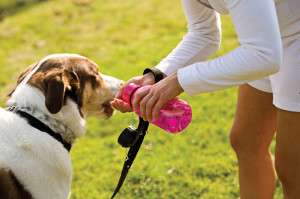 With the dog days of summer upon us, we as pet owners need to be aware of heatstroke with your pet. This can be a life-threatening condition that occurs because your pet cannot lower its body temperature efficiently, so its body temperature increases to dangerous levels.
With the dog days of summer upon us, we as pet owners need to be aware of heatstroke with your pet. This can be a life-threatening condition that occurs because your pet cannot lower its body temperature efficiently, so its body temperature increases to dangerous levels.
There are many common situations that can set the stage for heatstroke. These include: strenuous exercise in hot, humid weather, being a brachycephalic (short-nosed) breed, suffering from heart or lung disease that interferes with efficient breathing, being confined without shade or shelter and fresh water in hot weather, being confined on concrete or asphalt and the most logical-left in a closed up car in the warm weather.
Heatstroke begins with heavy panting and difficulty breathing. The tongue and mucous membranes appear bright red. The saliva is thick and tenacious and the dog usually vomits. The rectal temperature rises to 104 to 110 degrees Fahrenheit. The dog becomes progressively unsteady and passes bloody diarrhea. As shock sits in, the lips and mucous membranes turn gray. Collapse, seizures, coma and death rapidly ensue.
It is important to take emergency measures to begin cooling your pet immediately. One suggestion would be to move it to an air-conditioned building and begin cooling your pet with spraying your pet with a garden hose or immersing it in cool water for up to two minutes. Also if possible, it is helpful to place the wet pet in front of an electric fan. Ice packs work well when applied to the groin and armpit areas because this is the area where the blood is the closest to the surface in the body. Monitor the rectal temperature and continue the cooling process until it falls to 103 degrees. Seeking veterinary assistance is of utmost importance since this is an emergency. Your veterinarian will take steps to reverse the effects of heat, dehydration, and low blood pressure. An IV catheter will be placed and fluids will be given to help get blood flowing to major organs again.
Treatment is aimed to supporting these organs in the hope that the damage that they have sustained isn’t permanent. Unfortunately, it will often take days to know which organs have been affected. Specific treatments may include antibiotics, blood pressure medications and blood transfusions.
Because heatstroke can be so deadly and strike rapidly, it is best to take steps to prevent it. In hot weather, it is best to exercise your pet during the coolest part of the day (early morning and late evening) and always provide plenty of fresh, cool water and rest. A person can also help their pet by cooling them by allowing them to swim or spray them off with a hose after exercising.
Never leave a pet in a car during warm weather-not even for a few minutes with the windows cracked. Brachycephalic dog owners should be extra vigilant, keeping their dogs inside in air-conditioning on hot days. All geriatric, obese, and respiratory compromised pets should be exercised with caution in hot weather.
So remember if your pet is acting distressed, start cooling it down and seek assistance from your veterinarian immediately.
Summer Dangers For Pets
 Oh the dog days of summer. What’s not to like about summer? Vacations, cookouts, swimming—can it get any better than that? Wait a dog gone minute though. These fun times can be hazardous to your pets, so care must be taken to make sure that they don’t succumb to the dangers that can be lurking. Accidents can happen almost anytime and anyplace so it is important to be aware of how to prevent them from happening. These can include but not be limited to heat stroke, swimming pools, venomous pests, campouts, bbq and other foods just to name a few. So let’s cover a few dangers to avoid and try to prevent.
Oh the dog days of summer. What’s not to like about summer? Vacations, cookouts, swimming—can it get any better than that? Wait a dog gone minute though. These fun times can be hazardous to your pets, so care must be taken to make sure that they don’t succumb to the dangers that can be lurking. Accidents can happen almost anytime and anyplace so it is important to be aware of how to prevent them from happening. These can include but not be limited to heat stroke, swimming pools, venomous pests, campouts, bbq and other foods just to name a few. So let’s cover a few dangers to avoid and try to prevent.
Summer Heat
The summer heat can be dangerous to our pets. Dogs are covered with hair, have very few sweat glands, and some breeds have shortened noses that make it tough to keep cool in the summer. So the easiest way to beat the heat is to adjust your walking schedule to the morning hours when it is cooler out. Some dogs may do well with having their haircoat shaved, however breeds like the Husky have a haircoat that also helps keep them cool in the summer.
The heat will also warm up the inside of your car, so if it is above 65 degrees either leave your pet at home or take it inside with you when you leave the vehicle.
Sunburn can also cause some problems, so it may be important to put sunscreen on the pets ears and bare skin to prevent this.
Swimming Pools
What is a better way to beat the heat than swim in a swimming pool? It is great and it also is a good way for your dog to get exercise. Floatation devices are available to assist the pets that are not strong swimmers. But, do not leave them unsupervised. It is important that they be taught how to exit the pool safely before they tire. Also having fresh water for them to cool off with and to remove the chlorine, salt and bacteria that can be harmful to them is beneficial. So keep a bowl handy by the pool.
Fireworks
Almost everyone celebrates the Fourth of July with fireworks. Dogs tend to not like loud noises and can be scared easily. The best advice would be to leave your pets at home inside and away from the flash of the fireworks.
BBQs
Some summer evenings are spent socializing with friends and barbecuing. We all like them, and even our pets are hoping for a few table scraps. A little of this and a little of that can be bad for pets—and not just their waistlines. Some surprising foods like grapes, onions, garlic and raisins, can be toxic to dogs if consumed in large quantities and should stay off their menu. Other barbecue staples like corn on the cob, bones, fruit with pits, skewers or ice cream can be dangerous to our four-legged family members. It may be helpful to talk to guests and children before summer parties and politely remind them that table food could be detrimental to the health of your pet.
Fleas & Ticks
While our the heat puts a strain on our pets, fleas and ticks thrive during this time. They can cause disease and carry other parasites that are detrimental to the health of our pets. Just like humans, pets can have allergic reactions to insect and spider bites. By grooming your pet frequently, you can check for the presence of the pests, hot spots, and other skin problems that can be caused by these pests. There are some very good flea and tick medications out there to prevent the problems before they start, so talk with your veterinarian to see what they would suggest. You can also order directly from our store.
Heartworms
Heartworms are carried by mosquitos, and the summer months are when mosquitos thrive and pose the greatest threat to your pet. The heartworms can be very dangerous to the health of your pet. It is best to have your pet on a medication to prevent your pet from contracting the painful disease. So ask your veterinarian for their recommendations.
These dangers may sound scary, but a little preparation and watchful eye is all you need to take the heat off your summer. If you have any questions, please don’t hesitate to call the Olsen Veterinary Clinic at 618-656-5868, or contact us here.
